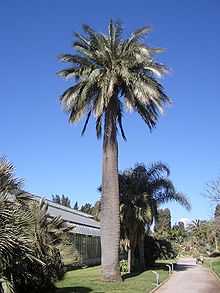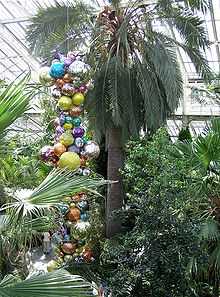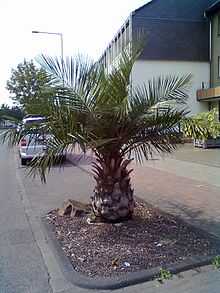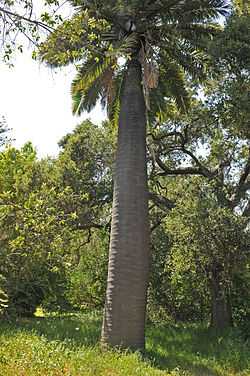Jubaea
| Chilean Wine Palm | |
|---|---|
 | |
| Conservation status | |
| Scientific classification | |
| Kingdom: | Plantae |
| (unranked): | Angiosperms |
| (unranked): | Monocots |
| (unranked): | Commelinids |
| Order: | Arecales |
| Family: | Arecaceae |
| Subfamily: | Arecoideae |
| Tribe: | Cocoeae |
| Genus: | Jubaea Kunth |
| Species: | J. chilensis |
| Binomial name | |
| Jubaea chilensis (Molina) Baill. | |
Jubaea chilensis (Chilean Wine Palm) is the sole extant species in the genus Jubaea in the palm family Arecaceae. It is native to southwestern South America, where it is endemic to a small area of central Chile, between 32°S and 35°S in southern Coquimbo, Valparaíso, Santiago, O'Higgins and northern Maule regions. It was long assumed that the extinct palm tree of Easter Island belonged to this genus too, but it is distinct and now placed in its own genus, Paschalococos.
It is a palm reaching heights of 25 metres (82 ft) with a trunk up to 1.3 metres (4.3 ft) in diameter at the base, often thicker higher up, and with smooth bark. The 3–5-metre (9.8–16.4 ft) leaves are pinnate. The largest individual specimen of indoor plant in the world is the Jubaea chilensis at Kew Gardens, England.

Etymology
The genus was named after Juba II, a Berber king and botanist.
Growth
The tree grows very slowly, as it is usual for palm trees. It takes several years until the Jubaea starts getting its weight and size. It may take more than 20 years for the plant to get the height of a medium tree.

Ecology
It needs mild winters, but will tolerate frosts down to about −15 °C (5 °F) as well as relatively cool summers, making it one of the hardiest of pinnate-leaved palms; this is because it grows up to 1,400 metres (4,600 ft) above sea level in its natural habitat. In the wild, the tree lives almost exclusively on the steep slopes of ravines. In the U.S. this palm grows best in the west from Seattle, Wa. south to San Diego, Ca. also east through Arizona, New Mexico, and west Texas, this palm suffers and can die in areas with extreme heat combined with high humidity.

Economic uses
_nuytsia_pix.jpg)
The common name refers to the past use of the sap from the trunk of this palm to produce a fermented beverage. The sap is also boiled down into a syrup and sold locally as miel de palma.
The tree also produces small round fruits that are about 2–3 centimetres (0.79–1.18 in) in diameter. The fruit has a very hard outer shell and whitish meat on the inside, like a miniature coconut. The fresh nuts are commonly sold in the areas where the palms grow during their fruiting season.
Conservation
The species is partially protected within Chile, although pressures of human overpopulation and expansion of grazing area have reduced the population of the Chilean Wine Palm in recent centuries.[2] Unlike most other palm wines, collecting the sap requires cutting down the tree; this harvesting also has reduced the population of Jubaea.
See also
![]() Media related to Jubaea at Wikimedia Commons
Media related to Jubaea at Wikimedia Commons
Line notes
References
- C. Donoso (2005) Árboles nativos de Chile. Guía de reconocimiento. Edición 4. Marisa Cuneo Ediciones, Valdivia, Chile. 136p
- González (1998). Jubaea chilensis. 2006. IUCN Red List of Threatened Species. IUCN 2006. www.iucnredlist.org. Retrieved on 11 May 2006. Listed as Vulnerable (VU A1cd v2.3)
- Information from Encyclopedia of Chilean Flora
- C. Michael Hogan (2008) Chilean Wine Palm: Jubaea chilensis, GlobalTwitcher.com, ed. Nicklas Stromberg
External links
- Jubaea chilensis species profile from Royal Botanic Gardens, Kew
- Pictures and information from grower
- Floridata: Jubaea chilensis; description and places in Europe where it has been introduced
- Philip W. Rundel (2002) The Chilean Wine Palm
- Palm & Cycad Society of Australia: Jubaea chilensis
- Cultivation in northern Europe
| ||||||||||||||||||||||||||||||||||||||||||||||||||||||||||||||||
